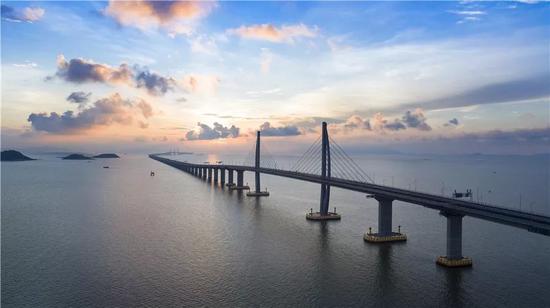
The Hong Kong-Zhuhai-Macao Bridge. (Photo/Xinhua) Observers anticipate greater mutual benefits through vision's realization The blueprint for the massive economic development that will turn the Guangdong-Hong Kong-Macao Greater Bay Area into a global economic powerhouse will be made public within days. Hong Kong Chief Executive Carrie Lam Cheng Yuet-ngor did not disclose the exact date for the release when speaking to reporters before Hong Kong's weekly Executive Council meeting on Tuesday. She did, however, announce that a conference on Feb 21 will begin poring over details of the project. Lam said the blueprint would lay out broad guidelines after which local governments in Guangdong province, Hong Kong and Macao will work together with the support of central government departments to pull the project together with concrete planning. Cross-sector heavyweights in Hong Kong welcomed the upcoming development blueprint, saying it could lead the city's different sectors into a stronger growth phase. Jonathan Choi Koon-shum, chairman of the Chinese General Chamber of Commerce in Hong Kong, said he believes the blueprint will demonstrate how to achieve mutual development without vicious competition among the participating cities. He also noted that Hong Kong enjoys an advantage in attracting international talent and providing world-class professional services. That's what Hong Kong can contribute to the development of the Greater Bay Area, Choi remarked. Choi's chamber is one of the leading business chambers in Hong Kong, with nearly 6,000 members from business and trade circles. Zhang Mingjie, a professor at the Division of Life Science at the Hong Kong University of Science and Technology, expressed high expectations for the outline, saying it would open the door to brighter prospects for Hong Kong's scientific and technological development. He anticipated that the plan would further connect the technology sectors of Hong Kong and the mainland, facilitating more career opportunities for Hong Kong local talent as well as offering a larger market for knowledge transfer. Tam Yiu-chung, a Hong Kong member of the Standing Committee of the National People's Congress, the country's top legislature, estimated that the plan would lay out development priorities for the area, and the key tasks each city should carry out. Hong Kong will thus have a clearer direction for future development, and better understand how it can fully contribute, Tam said. The Greater Bay Area encompasses Hong Kong and Macao, as well as nine cities in Guangdong province: Guangzhou, Shenzhen, Zhuhai, Dongguan, Huizhou, Zhongshan, Foshan, Zhaoqing and Jiangmen. In 2017, the 11 cities produced one-eighth of China's gross domestic product while containing only 5 percent of the nation's population and only 0.6 percent of China's total landmass. Stock markets in China edged up on Tuesday as market sentiment was partly boosted by the news about the upcoming Bay Area blueprint. The benchmark Shanghai Composite Index rose 0.68 percent to close at 2,671.89 points, while the Shenzhen Component Index closed 1.15 percent higher at 8,010.07 points. Gains were seen across Greater Bay Area-related sectors. Kaisa Group, which owns lots of land in the bay area, surged 3.5 percent, while Shenzhen International Holdings and Shenzhen Invest both notched healthy increases. 5G-related stocks were also up as China Tower closed 2.4 percent higher while Yangtze Optical Fibre and Cable climbed 3.5 percent. |